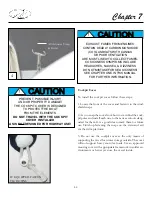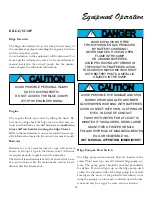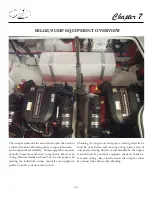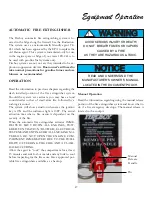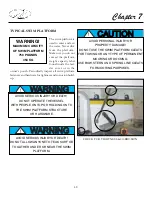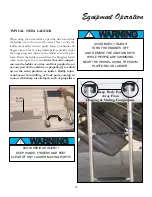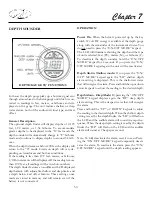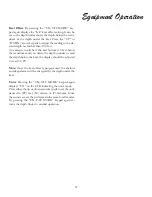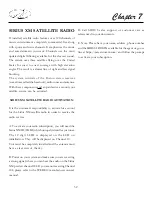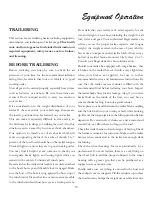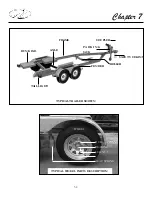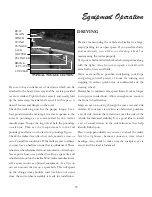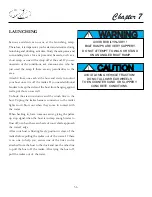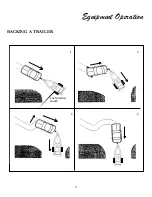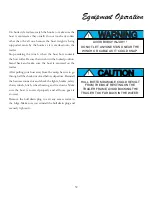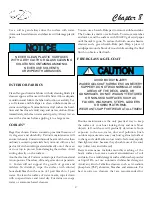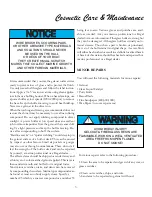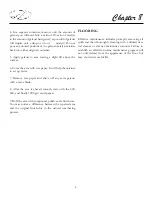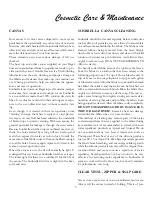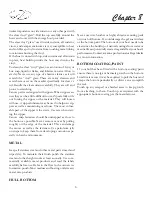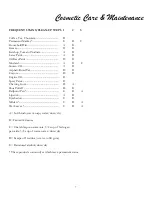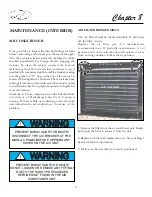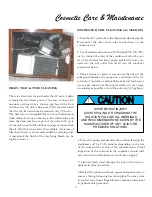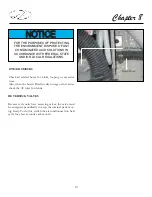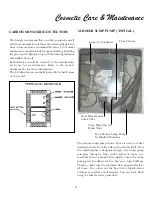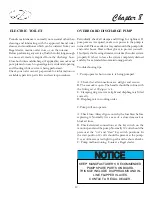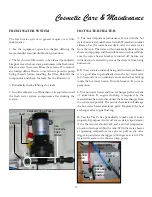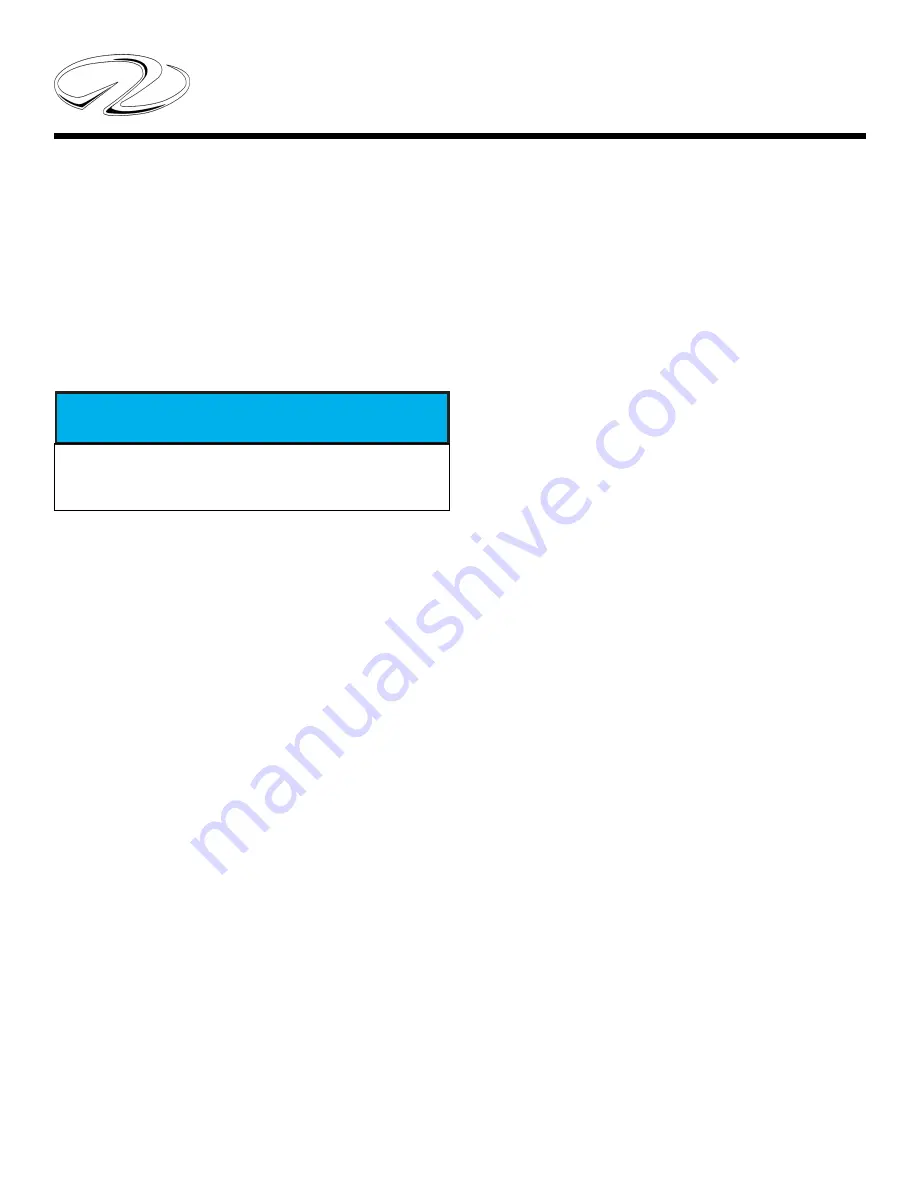
58
Chapter 7
A trailer backs in a direction opposite to an automobile.
In 1, driver swings the rig near the launching ramp. In 2,
the driver cuts the vehicle toward the driveway. In 3, the
driver cuts the vehicle wheels to the left and then backs
into the ramp as the trailer moves to the right. In 4, the
driver straightens the vehicle wheels to follow the trailer
as it backs down the ramp.
NOTICE
ALLOW WHEEL BEARINGS AND LIGHTS
TO COOL BEFORE SUBMERGING THEM.
LOADING BOAT
The most important thing to remember when getting your
boat out of the water is that often the ramp will be
crowded. As you approach the ramp, make a visual
inspection of the traffic, both at the ramp and all around
you. This is an important time to use caution, courtesy,
and common sense. While you may feel it’s your next
turn, another boater may not be as courteous. Don’t insist
on your rightful place in line; it could lead to disastrous
consequences in the confines of a crowded boat ramp. If
there is any perceived danger, stand off until you can
safely approach the ramp.
Back your trailer down to the water’s edge. At this point
it is a good idea to let a sufficient amount of line out of
the winch to reach the bow eye. Make sure you disconnect
the trailer harness to keep the bulbs from blowing out
due them being subjected to the cold water.
On roller or bunk style trailers back up until the aft roller
is just at the water level. This allows you to hook up the
winch cable and to start cranking the boat on to the trailer
properly. This method gives you a good starting point
and helps keep the boat centered on the trailer as it is
reloaded. It may be necessary to further back the trailer
into the water to allow cranking up the boat.
Once the boat is positioned correctly on the trailer have
someone hook up the winch cable hook to the bow eye.
Also, this will help keep the boat bow against the trailer
roller. Shut down the engine and run the outdrive up to
the top of the trailer position. With the bow snug against
the roller, start to crank the boat up onto the trailer. Make
sure the hull bottom or keel stays in the center of each
roller as it is being cranked on the trailer.
Consider disconnecting the trailer harness from the
vehicle harness at the ramp. That way the brake or running
lights will not work thus limiting the chances that a bulb
could burn out when backing the boat in the water
especially in colder climates.
Summary of Contents for 30 EXPRESS
Page 1: ...30 EXPRESS OWNER S MANUAL...
Page 2: ...784022 OWNER S MANUAL 30 EXPRESS 12 2012...
Page 30: ...11 Safety On Board NAVIGATION LIGHT RULES...
Page 41: ...Chapter 2 22 Notes...
Page 44: ...3 Rules Of The Road NAVIGATION RULES...
Page 85: ...28 Chapter 5 Notes...
Page 105: ...4 Chapter 7...
Page 106: ...5 Equipment Operation...
Page 107: ...6 Chapter 7...
Page 108: ...7 Equipment Operation...
Page 109: ...8 Chapter 7...
Page 110: ...9 Equipment Operation...
Page 111: ...10 Chapter 7...
Page 117: ...16 Chapter 7...
Page 126: ...25 Equipment Operation ROTARY ENCODER AND MENU KEY...
Page 127: ...26 Chapter 7 USING THE ROTARY ENCODER AND MENU KEY...
Page 158: ...57 Equipment Operation BACKING A TRAILER 1 2 3 4 LAUNCHING RAMP...
Page 161: ...60 Chapter 7 Notes...
Page 195: ...34 Chapter 8 Notes...
Page 204: ...9 Troubleshooting TOILET SYSTEM DIAGNOSTIC CHART...
Page 209: ...14 Chapter 9...
Page 219: ...6 Chapter 11 Notes...
Page 221: ...2 Chapter 12...
Page 224: ...5 Technical Information 30 Express Deck Overview 30 Express Cabin Overview...
Page 225: ...Technical Information 12 6 30 EXPRESS...
Page 226: ...12 7 Technical Information 30 EXPRESS...
Page 227: ...Technical Information 12 8 30 EXPRESS...
Page 228: ...12 9 Technical Information 30 EXPRESS...
Page 229: ...Technical Information 12 10 30 EXPRESS 30 EXPRESS...
Page 230: ...12 11 Technical Information TYPICAL NEGATIVE GROUND SYSTEM...
Page 231: ...Technical Information 12 12 30 EXPRESS...
Page 232: ...12 13 Technical Information 30 EXPRESS...

